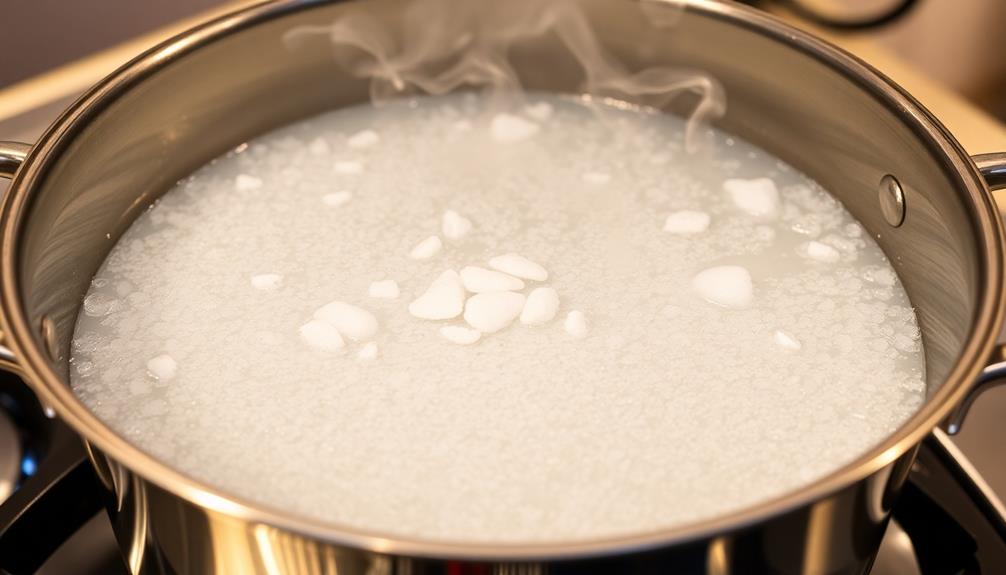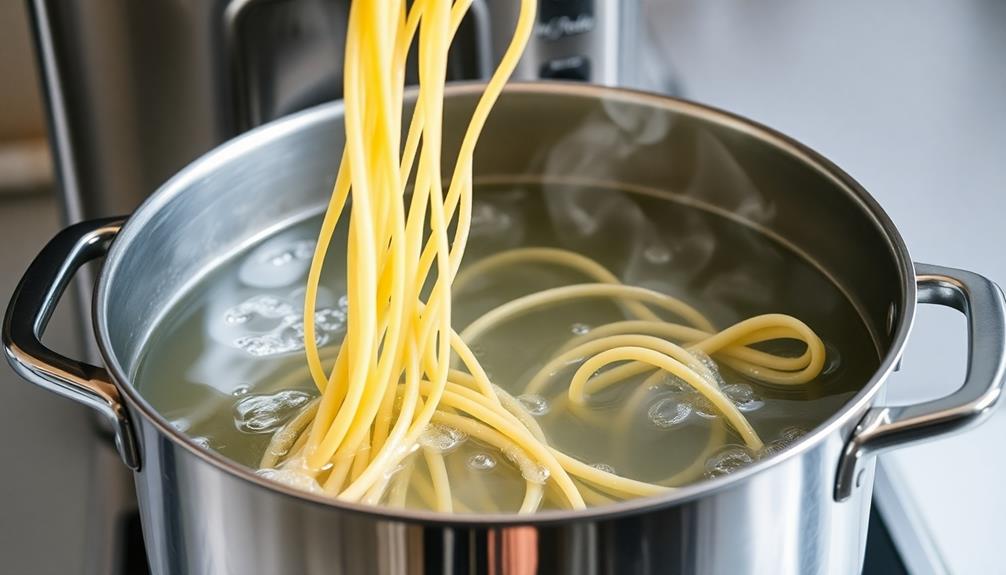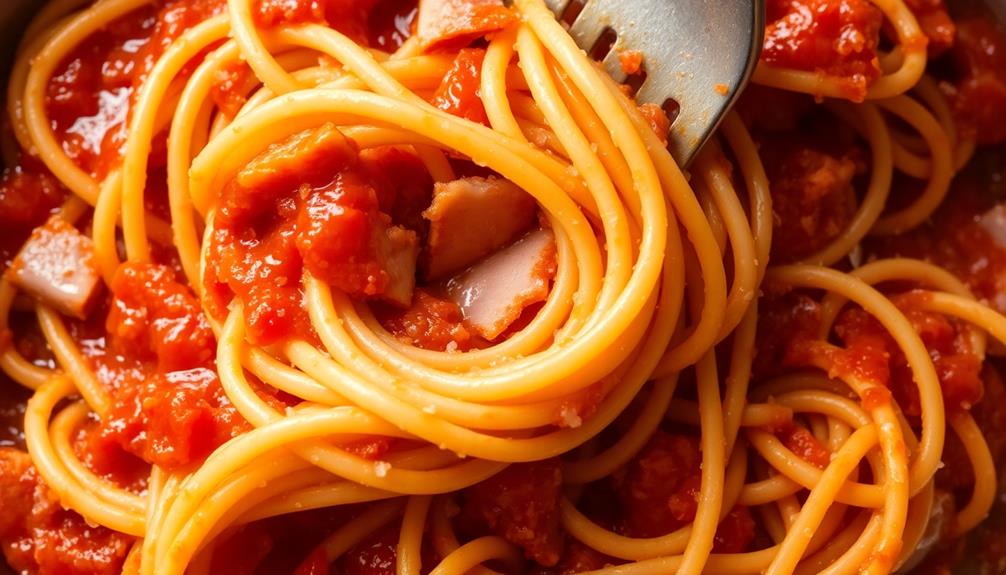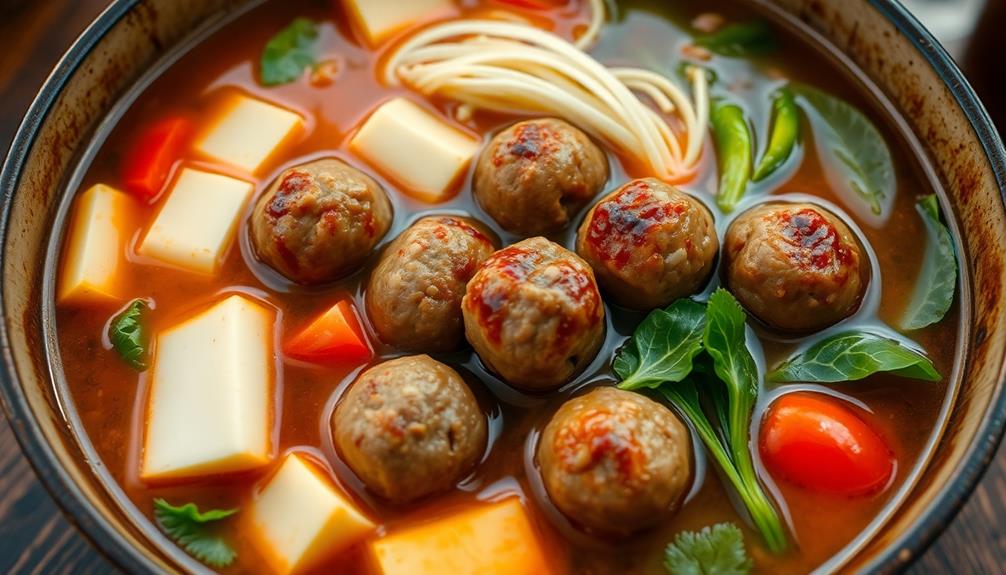You'll love taking a culinary trip to Italy's Lazio region with pasta all'Amatriciana! This classic dish traces back centuries, when local shepherds would whip it up using simple, high-quality ingredients. The star is guanciale, a cured pork cheek that adds heavenly flavor. Combined with sweet San Marzano tomatoes, spicy red pepper flakes, and Pecorino Romano cheese, it's a true taste of Italian tradition. Twirl your fork through al dente bucatini or spaghetti, and let the bold, comforting flavors transport you. Serve it up with a side of focaccia for a meal fit for a festa. There's more to discover about this beloved pasta dish!
Key Takeaways
- Pasta all'Amatriciana is a classic Italian dish originating from the Lazio region, featuring guanciale, tomatoes, and Pecorino Romano cheese as key ingredients.
- The dish has a rich history, tracing back to the 18th century when it was prepared by local shepherds in the Apennine mountains.
- The recipe highlights the use of high-quality, regional ingredients, emphasizing the simplicity and robust flavors of Italian cuisine.
- The dish is typically made with either bucatini or spaghetti pasta, and the combination of cured pork, tomatoes, and spice creates a harmonious balance of flavors.
- Pasta all'Amatriciana is considered a cornerstone of Italian gastronomy, representing the country's culinary heritage and the shared experience of enjoying a communal dish.
History
Amatriciana, a beloved pasta dish, is believed to have originated in the town of Amatrice, located in the Lazio region of Italy. This classic recipe has been passed down through generations, capturing the hearts and taste buds of pasta lovers around the world.
The dish's origins can be traced back to the 18th century, when local shepherds would prepare it using simple, inexpensive ingredients they'd on hand. The key components – guanciale (cured pork cheek), pecorino Romano cheese, and tomatoes – create a harmonious blend of flavors that has stood the test of time.
Over the years, Amatriciana has evolved, with some variations incorporating pancetta or even bacon. However, the traditional recipe remains a cherished part of Italian culinary heritage.
Whether enjoyed in the quaint streets of Amatrice or recreated in your own kitchen, this pasta dish is a true celebration of the country's rich gastronomic traditions.
Recipe
Pasta All'Amatriciana is a classic Italian dish originating from the town of Amatrice in the Lazio region. It's a simple yet flavorful pasta dish that combines the saltiness of guanciale (cured pork cheek) with the sweetness of tomatoes and the heat of red pepper flakes.
The dish's origins can be traced back to the 18th century, when shepherds living in the Apennine mountains would use the limited ingredients available to them to create a hearty and satisfying meal. Over time, the recipe has evolved, but the core flavors remain the same, making it a beloved dish among Italians and pasta enthusiasts worldwide.
- Guanciale, cut into small cubes
- Onion, diced
- Tomatoes, diced
- Red pepper flakes
- Pecorino Romano cheese, grated
- Bucatini or spaghetti pasta
- Salt and black pepper to taste
In a large skillet, cook the guanciale over medium heat until crispy and the fat has rendered. Remove the guanciale from the skillet, leaving the fat behind. Add the diced onion to the skillet and sauté until translucent.
Add the diced tomatoes and red pepper flakes, and cook for about 10 minutes, or until the sauce has thickened. Return the crispy guanciale to the skillet and season with salt and black pepper to taste.
While the sauce is simmering, cook the pasta in salted boiling water according to the package instructions. Drain the pasta and add it directly to the skillet with the sauce. Toss the pasta and sauce together, ensuring the pasta is evenly coated. Serve immediately, garnished with grated Pecorino Romano cheese.
When cooking this dish, it's important to use high-quality ingredients, especially the guanciale, as it provides the dish with its distinctive flavor and texture. If guanciale isn't available, you can substitute it with pancetta or bacon.
Additionally, feel free to adjust the amount of red pepper flakes to suit your preferred level of spiciness.
Cooking Steps
Bring a large pot of salted water to a boil, then cook the pasta according to the package instructions.
In a skillet, you'll fry up the guanciale until it's crispy.
Next, add your tantalizing tomato sauce, and toss everything together with the pasta for a delightful flavor explosion. Don’t forget to garnish with a sprinkle of fresh basil and grated parmesan cheese for an extra pop of flavor. The delicious homemade tomato sauce adds just the right amount of sweetness and acidity to complement the savory flavors of the pasta and vegetables. Your taste buds will thank you for this tantalizing and satisfying dish.
Step 1. Bring a Large Pot of Salted Water to a Boil

The pot, filled to the brim with water, takes its place on the stovetop. You turn the knob, and the burner springs to life, sending a gentle flame licking at the base of the pot.
As the water slowly starts to simmer, you grab a pinch of salt and sprinkle it over the surface, creating a delightful sizzle.
Soon, the water reaches a rolling boil, bubbles dancing and swirling, eager to welcome the pasta. It's time to add the noodles! Carefully, you pour them in, watching as they submerge and begin to soften.
Set a timer – in just a few minutes, the pasta will be perfectly al dente, ready to be drained and tossed with the amatriciana sauce.
The kitchen fills with the tantalizing aroma of the boiling water, a symphony of flavors just waiting to be unleashed.
Get ready, because the next steps are where the magic really begins!
Step 2. Cook Pasta According to Package Instructions

With the water at a rolling boil, it's time to cook the pasta according to the package instructions.
Carefully pour the pasta into the boiling water, making sure not to splash yourself. Stir the pasta gently to prevent it from sticking together. Follow the recommended cooking time on the package, usually around 8-12 minutes, until the pasta is tender but still has a slight bite to it.
Once the pasta is cooked, it's time to drain it.
Grab a colander and carefully pour the pasta into it, letting the hot water drain away. Give the pasta a gentle shake to remove any excess water.
Now, your perfectly cooked pasta is ready to be tossed with the delicious Amatriciana sauce. This classic Italian dish is sure to delight your taste buds and bring the flavors of Italy right to your table.
Step 3. In a Skillet, Cook the Guanciale

After draining the pasta, turn your attention to the guanciale. This cured pork jowl is the star of the show in an authentic amatriciana sauce.
In a skillet over medium heat, cook the guanciale until it's crispy and golden brown, about 5-7 minutes. Don't be afraid to let it sizzle – the fat will render out, creating the perfect base for your sauce.
Once the guanciale is crispy, remove any excess fat, leaving just a couple of tablespoons in the pan. This flavorful fat will be the foundation for your sauce.
Now it's time to add the aromatic ingredients. Toss in some minced garlic and a pinch of red pepper flakes, and sauté for about a minute, until the garlic is fragrant and the pepper flakes are toasted.
The guanciale is ready, and your kitchen is filled with the tantalizing aroma of this classic Roman dish.
Get ready to toss the pasta and sauce together for a truly delizioso experience!
Step 4. Add Tomato Sauce

Next, add the canned tomatoes to the skillet with the crispy guanciale and sautéed garlic. Give it a good stir to combine everything. The bright, tangy tomato sauce will mingle with the savory guanciale and fragrant garlic, creating a mouthwatering aroma that fills the kitchen.
Simmer the sauce for about 10 minutes, allowing the flavors to meld together. Stir occasionally to prevent sticking. As the sauce simmers, it will thicken up and become nice and saucy, perfect for coating your freshly cooked pasta.
Once the sauce has reached your desired consistency, give it a taste. Add a pinch of salt and pepper if needed to balance the flavors. You want the sauce to be well-seasoned and bursting with that classic amatriciana taste.
Now you're ready to toss the hot pasta right into the skillet with the saucy guanciale mixture. Give everything a good toss to coat the noodles evenly. Dinner is almost ready!
Step 5. Toss Pasta With Sauce and Guanciale

Now, toss the hot pasta right into the skillet with the saucy guanciale mixture.
Stir everything together vigorously to coat each strand of pasta. The salty, savory guanciale will cling to the nooks and crannies, creating a heavenly flavor explosion in your mouth.
Next, add a splash of the starchy pasta cooking water.
This will help the sauce emulsify and cling to the pasta. Toss and stir until the sauce becomes silky smooth and coats every inch.
Final Thoughts
Pasta all'Amatriciana is a timeless classic that encapsulates the essence of Italian cuisine. Its roots trace back to the Lazio region, where simple ingredients are transformed into a remarkable dish.
It's a dish that brings family and friends together, creating memories that last a lifetime. The perfect balance of salty guanciale, tangy tomatoes, and al dente pasta makes this recipe an absolute delight. For those who appreciate the art of Italian cooking, easy tomato focaccia serves as a wonderful accompaniment.
As you toss the pasta with the vibrant sauce, you can't help but feel a sense of pride and accomplishment. This dish isn't only delicious but also a testament to the rich culinary traditions of Italy.
Whether you're sharing it with loved ones or enjoying it on your own, it's a meal that truly nourishes the soul.
Frequently Asked Questions
What Is the Origin of the Name "Amatriciana"?
You're wondering about the origin of the name "amatriciana," aren't you? The dish takes its name from the town of Amatrice in Italy, where it was first created and popularized. The name reflects the dish's regional roots.
Can I Substitute Guanciale With Another Type of Cured Pork?
You can substitute guanciale with other types of cured pork, like pancetta or bacon. However, the flavor profile may differ from the traditional dish's taste since guanciale has a distinct pork cheek flavor.
How Do I Achieve the Perfect Balance of Saltiness and Spiciness?
To achieve the perfect balance of saltiness and spiciness, you'll need to experiment with the ratio of cured pork, Pecorino Romano, and red pepper flakes. Start with a small amount of each and adjust to your taste.
Is It Possible to Make a Vegetarian Version of Pasta All'amatriciana?
Yes, you can absolutely make a vegetarian version of this dish. Simply swap out the traditional guanciale or pancetta for sautéed mushrooms or eggplant, and you'll have a delicious meatless take on this classic Italian pasta.
How Long Can I Store Leftover Pasta All'amatriciana?
You can store leftover pasta dishes in the refrigerator for 3-4 days. Make sure to store them in an airtight container to retain freshness. Enjoy your leftovers within this timeframe for the best quality and taste.









